Dissertation: Temperature Effects on FRP Reinforced Concrete Beams
VerifiedAdded on 2023/06/10
|50
|16967
|419
Project
AI Summary
This project models the behavior of Fiber Reinforced Polymer (FRP) reinforced concrete beams under varying temperatures, as outlined in the assignment brief. The project utilizes ANSYS software to simulate the effects of temperature changes (ranging from -20°C to 50°C) on FRP beams, drawing upon experimental data from two research papers. The study investigates how different temperatures influence the strain and deflection of both steel and GFRP reinforced concrete beams under various load conditions. The methodology involves creating beam models in ANSYS, applying different loads, and simulating temperature fluctuations. The results are then analyzed to compare the performance of steel and GFRP reinforced beams under these conditions. The project aims to determine the impact of temperature on the structural integrity and performance of FRP beams and to compare the effectiveness of GFRP as a reinforcement material in extreme weather conditions. The findings are summarized, and conclusions are drawn regarding the suitability of FRP reinforced concrete in various climates. The project adheres to the structure of the provided paper and the literature review requirement of 4000 words and a total word count of 12000 words.
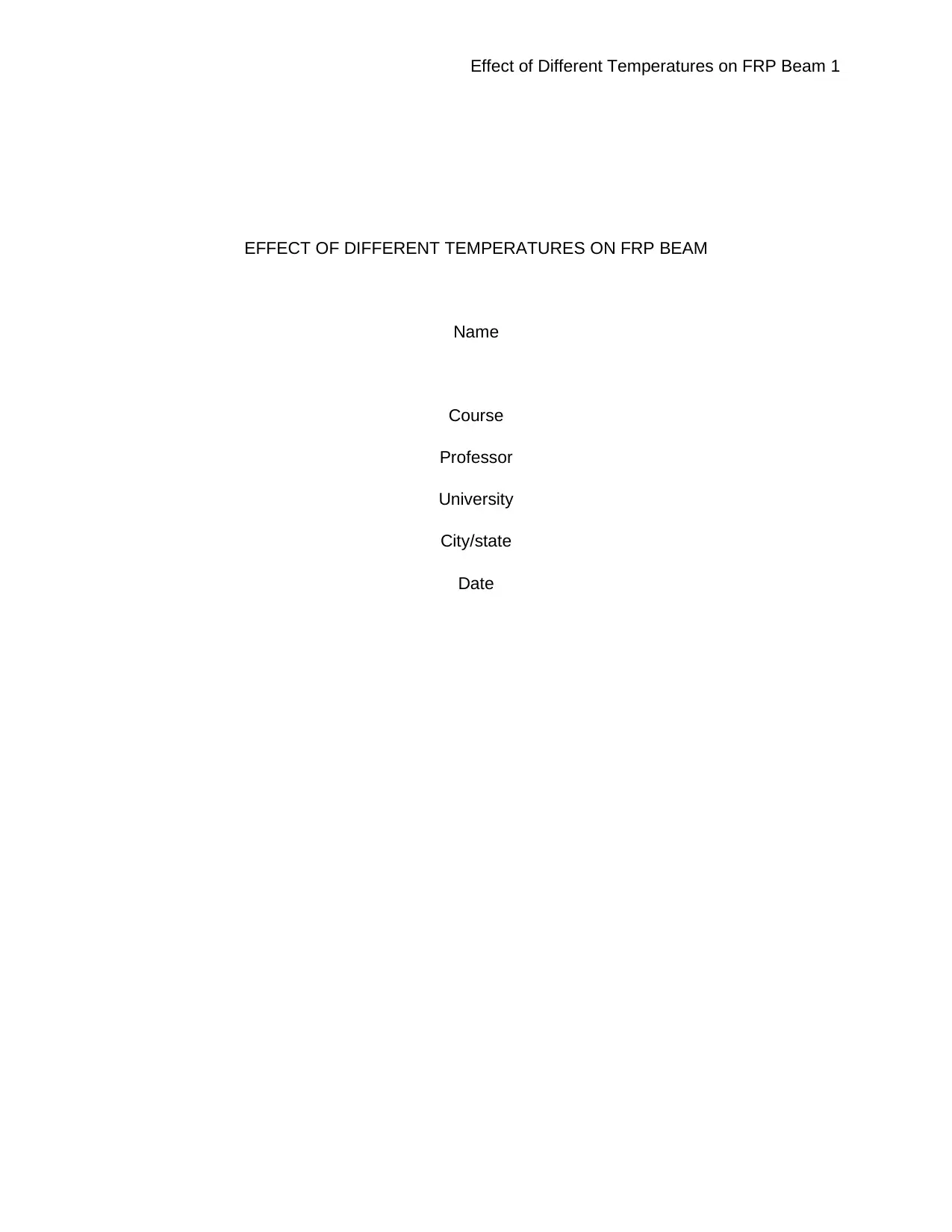
Effect of Different Temperatures on FRP Beam 1
EFFECT OF DIFFERENT TEMPERATURES ON FRP BEAM
Name
Course
Professor
University
City/state
Date
EFFECT OF DIFFERENT TEMPERATURES ON FRP BEAM
Name
Course
Professor
University
City/state
Date
Paraphrase This Document
Need a fresh take? Get an instant paraphrase of this document with our AI Paraphraser

Effect of Different Temperatures on FRP Beam 2
Abstract
Construction industry is one of the leading markets for fiber reinforced polymers (FRP) all over
the world. FRP composites have numerous applications in industry because of the advantages
they offer over conventional construction materials. These advantages include the following:
high mechanical performance, lightness, design and manufacturing or production flexibility, high
specific stiffness and strength, low maintenance costs, ease of installation and controlled
anisotropy, among others. Unfortunately, FRP composites are prone to moisture and heat when
they are exposed to fluctuating environmental conditions. FRP composites’ response to heat is
one of the major issues dictating their acceptance and applicability in the construction industry.
The main concern is that the stability, functionality, safety and durability of FRP composites
structures may deteriorate if they are exposed to extreme temperatures. This paper involves
investigating the effect of temperature changes on FRP reinforced concrete beams. The study
was performed so as to show the lab experiment results obtained from two papers “Investigation
on influence of freeze/thaw on reinforced concrete beams with GFRP” by Waqas Khattak, and
“Effect of environmental temperature on FRP reinforced concrete beams” by Atikom
Ongphichetmetha. These results were obtained by preparing samples of FRP reinforced
concrete beams and loading them under different loads and varying temperature of between -20
°C and 50 °C. The data obtained was then used in ANSYS software to model the behaviour of
the beams so as to establish how temperature changes affect various properties of the FRP
reinforced concrete beams. The model was created by particular elements of ANSYS for
concrete, steel reinforcement bars, FRP reinforcement bars and steel plates. The beam model
was then subjected to different loads of 0KN, 2KN, 4KN, 6KN, 8KN and 10KN. Under each of
these loads, the beam model was tested under varying temperature by increasing temperature
from 20 °C to 50 °C (where it was held constant for 2 hours), dropping the temperature from 50
°C to -20 °C (where it was also held constant for 2 hours) and finally raising the temperature to
20 °C. The software simulated the behaviour of the model at these varying loading conditions
and temperatures.
The behaviour of steel and GFRP reinforced concrete beams, as shown by ANSYS simulation,
was similar but identical. This was as expected because the two types of materials have
different values of Young’s modulus and coefficient of expansion. Generally, the two beams had
a similar trend where deflection and train were proportional to load and temperature (an
increase in load or temperature resulted to a corresponding increase in deflection r strain, and
vice versa). Since the coefficient of expansion of steel is more than that of GFRP, former had
minimal reaction of strain than the later when subjected to the same loading conditions and
Abstract
Construction industry is one of the leading markets for fiber reinforced polymers (FRP) all over
the world. FRP composites have numerous applications in industry because of the advantages
they offer over conventional construction materials. These advantages include the following:
high mechanical performance, lightness, design and manufacturing or production flexibility, high
specific stiffness and strength, low maintenance costs, ease of installation and controlled
anisotropy, among others. Unfortunately, FRP composites are prone to moisture and heat when
they are exposed to fluctuating environmental conditions. FRP composites’ response to heat is
one of the major issues dictating their acceptance and applicability in the construction industry.
The main concern is that the stability, functionality, safety and durability of FRP composites
structures may deteriorate if they are exposed to extreme temperatures. This paper involves
investigating the effect of temperature changes on FRP reinforced concrete beams. The study
was performed so as to show the lab experiment results obtained from two papers “Investigation
on influence of freeze/thaw on reinforced concrete beams with GFRP” by Waqas Khattak, and
“Effect of environmental temperature on FRP reinforced concrete beams” by Atikom
Ongphichetmetha. These results were obtained by preparing samples of FRP reinforced
concrete beams and loading them under different loads and varying temperature of between -20
°C and 50 °C. The data obtained was then used in ANSYS software to model the behaviour of
the beams so as to establish how temperature changes affect various properties of the FRP
reinforced concrete beams. The model was created by particular elements of ANSYS for
concrete, steel reinforcement bars, FRP reinforcement bars and steel plates. The beam model
was then subjected to different loads of 0KN, 2KN, 4KN, 6KN, 8KN and 10KN. Under each of
these loads, the beam model was tested under varying temperature by increasing temperature
from 20 °C to 50 °C (where it was held constant for 2 hours), dropping the temperature from 50
°C to -20 °C (where it was also held constant for 2 hours) and finally raising the temperature to
20 °C. The software simulated the behaviour of the model at these varying loading conditions
and temperatures.
The behaviour of steel and GFRP reinforced concrete beams, as shown by ANSYS simulation,
was similar but identical. This was as expected because the two types of materials have
different values of Young’s modulus and coefficient of expansion. Generally, the two beams had
a similar trend where deflection and train were proportional to load and temperature (an
increase in load or temperature resulted to a corresponding increase in deflection r strain, and
vice versa). Since the coefficient of expansion of steel is more than that of GFRP, former had
minimal reaction of strain than the later when subjected to the same loading conditions and

Effect of Different Temperatures on FRP Beam 3
temperature. Also, steel has a smaller Young’ modulus than GFRP thus the former had less
deflection than the later. Therefore the conclusion from this study is that temperature affects the
behaviour of steel reinforced ad GFRP reinforced concrete beams. Also, based on the
simulations obtained from this study, it can be concluded that since the values of strain in GFRP
reinforced concrete beam were smaller than those of steel reinforced concrete beam, GFRP is a
better reinforcement material than steel for use when constructing concrete structures in
extreme weather conditions, such as cold or hot climates.
temperature. Also, steel has a smaller Young’ modulus than GFRP thus the former had less
deflection than the later. Therefore the conclusion from this study is that temperature affects the
behaviour of steel reinforced ad GFRP reinforced concrete beams. Also, based on the
simulations obtained from this study, it can be concluded that since the values of strain in GFRP
reinforced concrete beam were smaller than those of steel reinforced concrete beam, GFRP is a
better reinforcement material than steel for use when constructing concrete structures in
extreme weather conditions, such as cold or hot climates.
⊘ This is a preview!⊘
Do you want full access?
Subscribe today to unlock all pages.

Trusted by 1+ million students worldwide
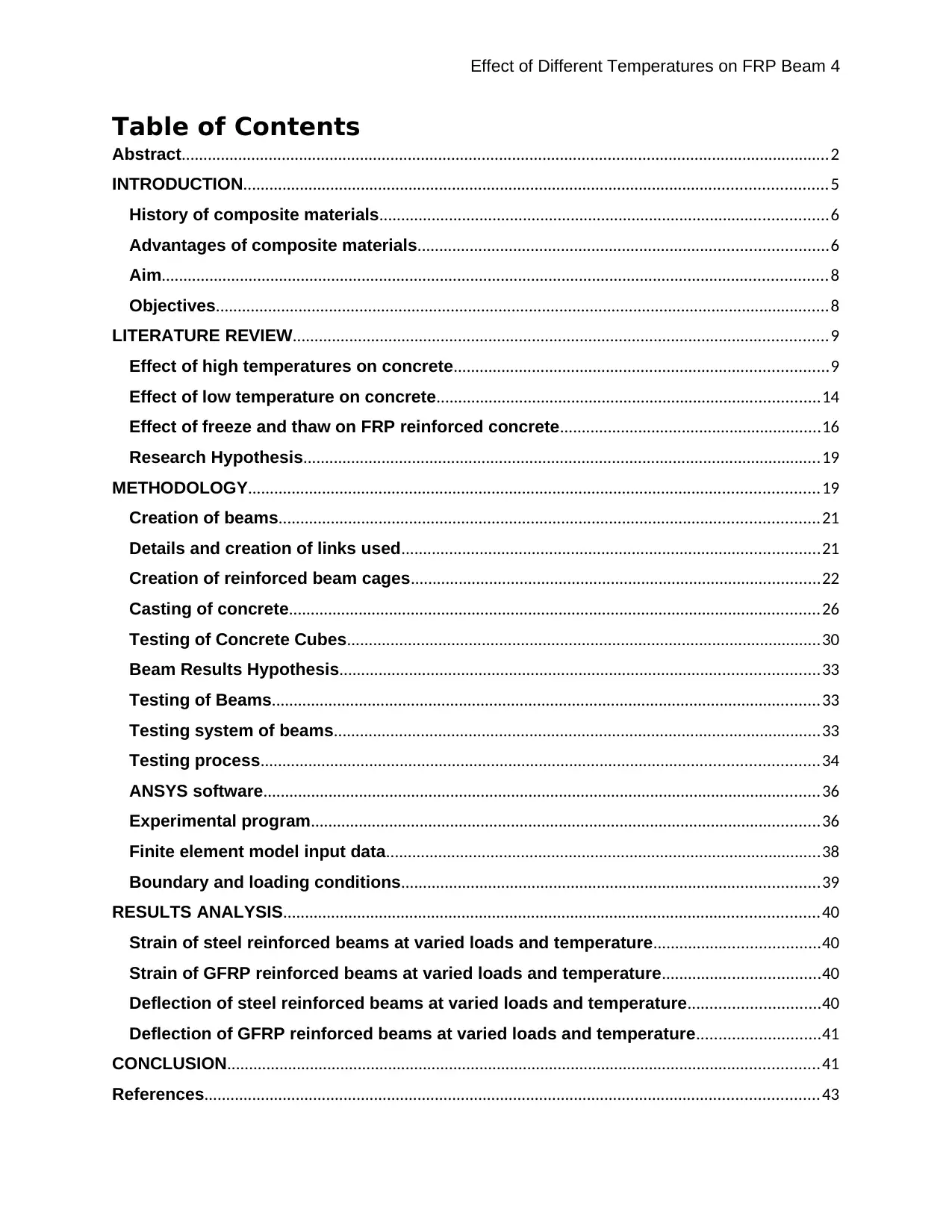
Effect of Different Temperatures on FRP Beam 4
Table of Contents
Abstract.....................................................................................................................................................2
INTRODUCTION......................................................................................................................................5
History of composite materials.......................................................................................................6
Advantages of composite materials..............................................................................................6
Aim.........................................................................................................................................................8
Objectives.............................................................................................................................................8
LITERATURE REVIEW...........................................................................................................................9
Effect of high temperatures on concrete......................................................................................9
Effect of low temperature on concrete........................................................................................14
Effect of freeze and thaw on FRP reinforced concrete............................................................16
Research Hypothesis.......................................................................................................................19
METHODOLOGY...................................................................................................................................19
Creation of beams............................................................................................................................21
Details and creation of links used................................................................................................21
Creation of reinforced beam cages..............................................................................................22
Casting of concrete..........................................................................................................................26
Testing of Concrete Cubes.............................................................................................................30
Beam Results Hypothesis..............................................................................................................33
Testing of Beams..............................................................................................................................33
Testing system of beams................................................................................................................33
Testing process................................................................................................................................34
ANSYS software................................................................................................................................36
Experimental program.....................................................................................................................36
Finite element model input data....................................................................................................38
Boundary and loading conditions................................................................................................39
RESULTS ANALYSIS...........................................................................................................................40
Strain of steel reinforced beams at varied loads and temperature......................................40
Strain of GFRP reinforced beams at varied loads and temperature....................................40
Deflection of steel reinforced beams at varied loads and temperature..............................40
Deflection of GFRP reinforced beams at varied loads and temperature............................41
CONCLUSION........................................................................................................................................41
References.............................................................................................................................................43
Table of Contents
Abstract.....................................................................................................................................................2
INTRODUCTION......................................................................................................................................5
History of composite materials.......................................................................................................6
Advantages of composite materials..............................................................................................6
Aim.........................................................................................................................................................8
Objectives.............................................................................................................................................8
LITERATURE REVIEW...........................................................................................................................9
Effect of high temperatures on concrete......................................................................................9
Effect of low temperature on concrete........................................................................................14
Effect of freeze and thaw on FRP reinforced concrete............................................................16
Research Hypothesis.......................................................................................................................19
METHODOLOGY...................................................................................................................................19
Creation of beams............................................................................................................................21
Details and creation of links used................................................................................................21
Creation of reinforced beam cages..............................................................................................22
Casting of concrete..........................................................................................................................26
Testing of Concrete Cubes.............................................................................................................30
Beam Results Hypothesis..............................................................................................................33
Testing of Beams..............................................................................................................................33
Testing system of beams................................................................................................................33
Testing process................................................................................................................................34
ANSYS software................................................................................................................................36
Experimental program.....................................................................................................................36
Finite element model input data....................................................................................................38
Boundary and loading conditions................................................................................................39
RESULTS ANALYSIS...........................................................................................................................40
Strain of steel reinforced beams at varied loads and temperature......................................40
Strain of GFRP reinforced beams at varied loads and temperature....................................40
Deflection of steel reinforced beams at varied loads and temperature..............................40
Deflection of GFRP reinforced beams at varied loads and temperature............................41
CONCLUSION........................................................................................................................................41
References.............................................................................................................................................43
Paraphrase This Document
Need a fresh take? Get an instant paraphrase of this document with our AI Paraphraser

Effect of Different Temperatures on FRP Beam 5
INTRODUCTION
Concrete is one of the oldest and widely used construction material. This is because of
various reasons, including simple methods of concrete production, high strength and durability
of concrete, design flexibility of concrete structures, etc. However, concrete as a construction
material has one major problem: it has low tensile strength. To overcome this problem,
reinforcement is added to the concrete to make it stronger. The new material formed then
becomes reinforced concrete, which is a composite material. The composite material contains
concrete (which has high compressive strength but low tensile strength) and reinforcement
(which has low compressive strength but high tensile strength). In other words, the concrete
complements the weakness of reinforcement whereas the reinforcement complements the
weakness of concrete. Therefore the reinforced concrete is a stronger material that is able to
resist both compressive and tensile loads applied on it. The most common concrete
reinforcement material is steel but numerous alternatives have been developed, such as glass
reinforcement, fiber reinforcement, plastic reinforcement, polymer reinforcement and several
composite reinforcements.
Composites are basically materials comprising of a combination of two or more materials
with different structural, physical, mechanical and chemical properties. FRP is a composite
material comprising of a matrix (polymer) and reinforcement (fibres). The fibers are stiffer and
stronger whereas the polymer is used as a binder to keep the reinforcement in place and also to
protect the reinforcement. The individual materials of a composite do not have the capacity to
perform the desired structural function but they do so when combined because one material
complements the weakness of the other material. For FRP reinforced concrete, the fibers
provide stiffness and strength to carry the largest percentage of the applied loads (Kakooei, et
al., 2012). On the other hand, the polymer binds the fibers, protects the fibers and transfers
most of the stresses developed in the concrete component.
The search for alternative building materials will never stop. Engineers, architects,
designers and developers are always looking for materials that have improved properties, such
as high strength, lightweight, sustainable, low-cost, environmentally friendly, durable, flexible
and resistant to extreme environmental conditions (Zaman, et al., 2013). These materials should
also perform the required function adequately and offer economic and environmental benefits.
Over the past decades, FRP has been found to be one of the best viable alternatives for
concrete structures (Bai, 2013); (Hawileh, 2011). As a result, use of FRP reinforced concrete
INTRODUCTION
Concrete is one of the oldest and widely used construction material. This is because of
various reasons, including simple methods of concrete production, high strength and durability
of concrete, design flexibility of concrete structures, etc. However, concrete as a construction
material has one major problem: it has low tensile strength. To overcome this problem,
reinforcement is added to the concrete to make it stronger. The new material formed then
becomes reinforced concrete, which is a composite material. The composite material contains
concrete (which has high compressive strength but low tensile strength) and reinforcement
(which has low compressive strength but high tensile strength). In other words, the concrete
complements the weakness of reinforcement whereas the reinforcement complements the
weakness of concrete. Therefore the reinforced concrete is a stronger material that is able to
resist both compressive and tensile loads applied on it. The most common concrete
reinforcement material is steel but numerous alternatives have been developed, such as glass
reinforcement, fiber reinforcement, plastic reinforcement, polymer reinforcement and several
composite reinforcements.
Composites are basically materials comprising of a combination of two or more materials
with different structural, physical, mechanical and chemical properties. FRP is a composite
material comprising of a matrix (polymer) and reinforcement (fibres). The fibers are stiffer and
stronger whereas the polymer is used as a binder to keep the reinforcement in place and also to
protect the reinforcement. The individual materials of a composite do not have the capacity to
perform the desired structural function but they do so when combined because one material
complements the weakness of the other material. For FRP reinforced concrete, the fibers
provide stiffness and strength to carry the largest percentage of the applied loads (Kakooei, et
al., 2012). On the other hand, the polymer binds the fibers, protects the fibers and transfers
most of the stresses developed in the concrete component.
The search for alternative building materials will never stop. Engineers, architects,
designers and developers are always looking for materials that have improved properties, such
as high strength, lightweight, sustainable, low-cost, environmentally friendly, durable, flexible
and resistant to extreme environmental conditions (Zaman, et al., 2013). These materials should
also perform the required function adequately and offer economic and environmental benefits.
Over the past decades, FRP has been found to be one of the best viable alternatives for
concrete structures (Bai, 2013); (Hawileh, 2011). As a result, use of FRP reinforced concrete
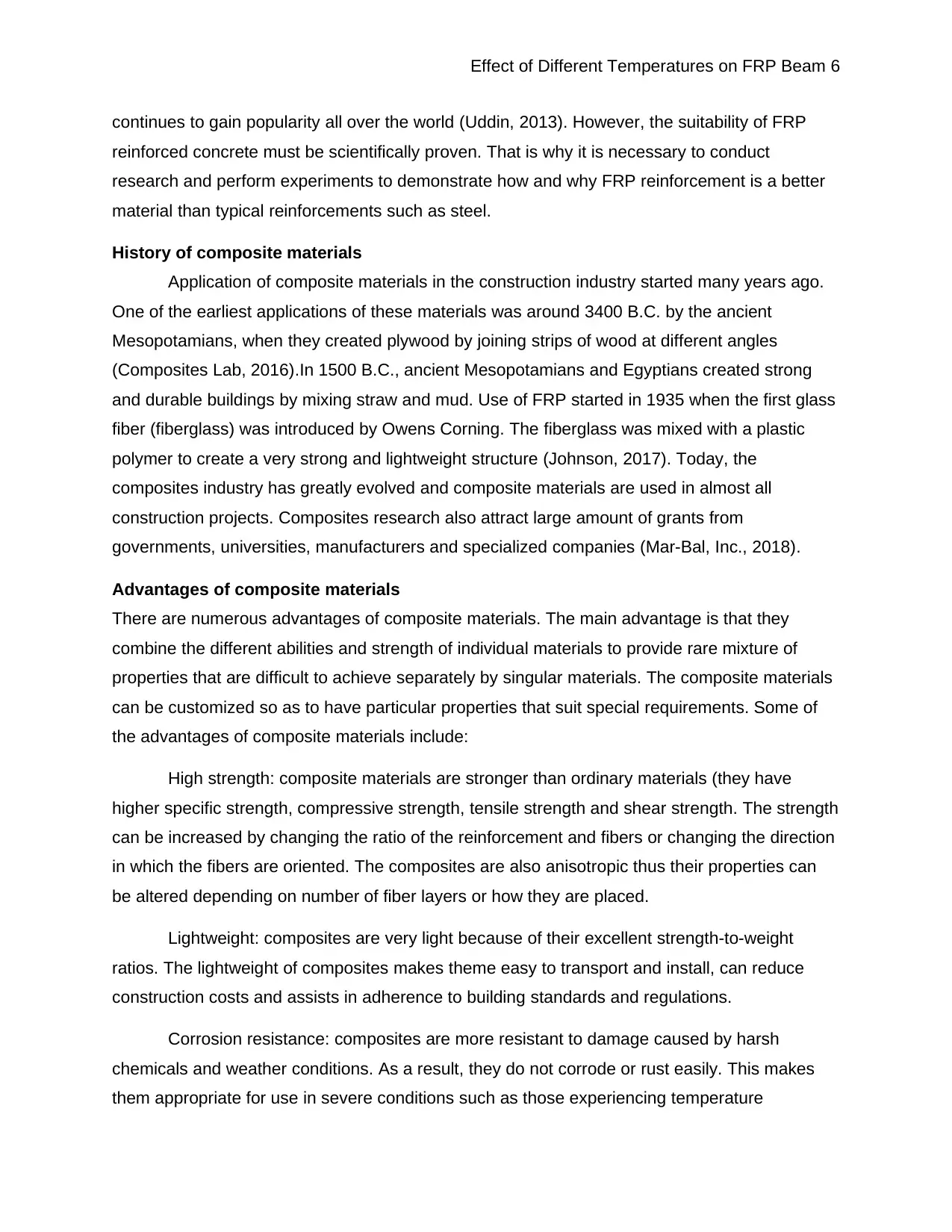
Effect of Different Temperatures on FRP Beam 6
continues to gain popularity all over the world (Uddin, 2013). However, the suitability of FRP
reinforced concrete must be scientifically proven. That is why it is necessary to conduct
research and perform experiments to demonstrate how and why FRP reinforcement is a better
material than typical reinforcements such as steel.
History of composite materials
Application of composite materials in the construction industry started many years ago.
One of the earliest applications of these materials was around 3400 B.C. by the ancient
Mesopotamians, when they created plywood by joining strips of wood at different angles
(Composites Lab, 2016).In 1500 B.C., ancient Mesopotamians and Egyptians created strong
and durable buildings by mixing straw and mud. Use of FRP started in 1935 when the first glass
fiber (fiberglass) was introduced by Owens Corning. The fiberglass was mixed with a plastic
polymer to create a very strong and lightweight structure (Johnson, 2017). Today, the
composites industry has greatly evolved and composite materials are used in almost all
construction projects. Composites research also attract large amount of grants from
governments, universities, manufacturers and specialized companies (Mar-Bal, Inc., 2018).
Advantages of composite materials
There are numerous advantages of composite materials. The main advantage is that they
combine the different abilities and strength of individual materials to provide rare mixture of
properties that are difficult to achieve separately by singular materials. The composite materials
can be customized so as to have particular properties that suit special requirements. Some of
the advantages of composite materials include:
High strength: composite materials are stronger than ordinary materials (they have
higher specific strength, compressive strength, tensile strength and shear strength. The strength
can be increased by changing the ratio of the reinforcement and fibers or changing the direction
in which the fibers are oriented. The composites are also anisotropic thus their properties can
be altered depending on number of fiber layers or how they are placed.
Lightweight: composites are very light because of their excellent strength-to-weight
ratios. The lightweight of composites makes theme easy to transport and install, can reduce
construction costs and assists in adherence to building standards and regulations.
Corrosion resistance: composites are more resistant to damage caused by harsh
chemicals and weather conditions. As a result, they do not corrode or rust easily. This makes
them appropriate for use in severe conditions such as those experiencing temperature
continues to gain popularity all over the world (Uddin, 2013). However, the suitability of FRP
reinforced concrete must be scientifically proven. That is why it is necessary to conduct
research and perform experiments to demonstrate how and why FRP reinforcement is a better
material than typical reinforcements such as steel.
History of composite materials
Application of composite materials in the construction industry started many years ago.
One of the earliest applications of these materials was around 3400 B.C. by the ancient
Mesopotamians, when they created plywood by joining strips of wood at different angles
(Composites Lab, 2016).In 1500 B.C., ancient Mesopotamians and Egyptians created strong
and durable buildings by mixing straw and mud. Use of FRP started in 1935 when the first glass
fiber (fiberglass) was introduced by Owens Corning. The fiberglass was mixed with a plastic
polymer to create a very strong and lightweight structure (Johnson, 2017). Today, the
composites industry has greatly evolved and composite materials are used in almost all
construction projects. Composites research also attract large amount of grants from
governments, universities, manufacturers and specialized companies (Mar-Bal, Inc., 2018).
Advantages of composite materials
There are numerous advantages of composite materials. The main advantage is that they
combine the different abilities and strength of individual materials to provide rare mixture of
properties that are difficult to achieve separately by singular materials. The composite materials
can be customized so as to have particular properties that suit special requirements. Some of
the advantages of composite materials include:
High strength: composite materials are stronger than ordinary materials (they have
higher specific strength, compressive strength, tensile strength and shear strength. The strength
can be increased by changing the ratio of the reinforcement and fibers or changing the direction
in which the fibers are oriented. The composites are also anisotropic thus their properties can
be altered depending on number of fiber layers or how they are placed.
Lightweight: composites are very light because of their excellent strength-to-weight
ratios. The lightweight of composites makes theme easy to transport and install, can reduce
construction costs and assists in adherence to building standards and regulations.
Corrosion resistance: composites are more resistant to damage caused by harsh
chemicals and weather conditions. As a result, they do not corrode or rust easily. This makes
them appropriate for use in severe conditions such as those experiencing temperature
⊘ This is a preview!⊘
Do you want full access?
Subscribe today to unlock all pages.

Trusted by 1+ million students worldwide
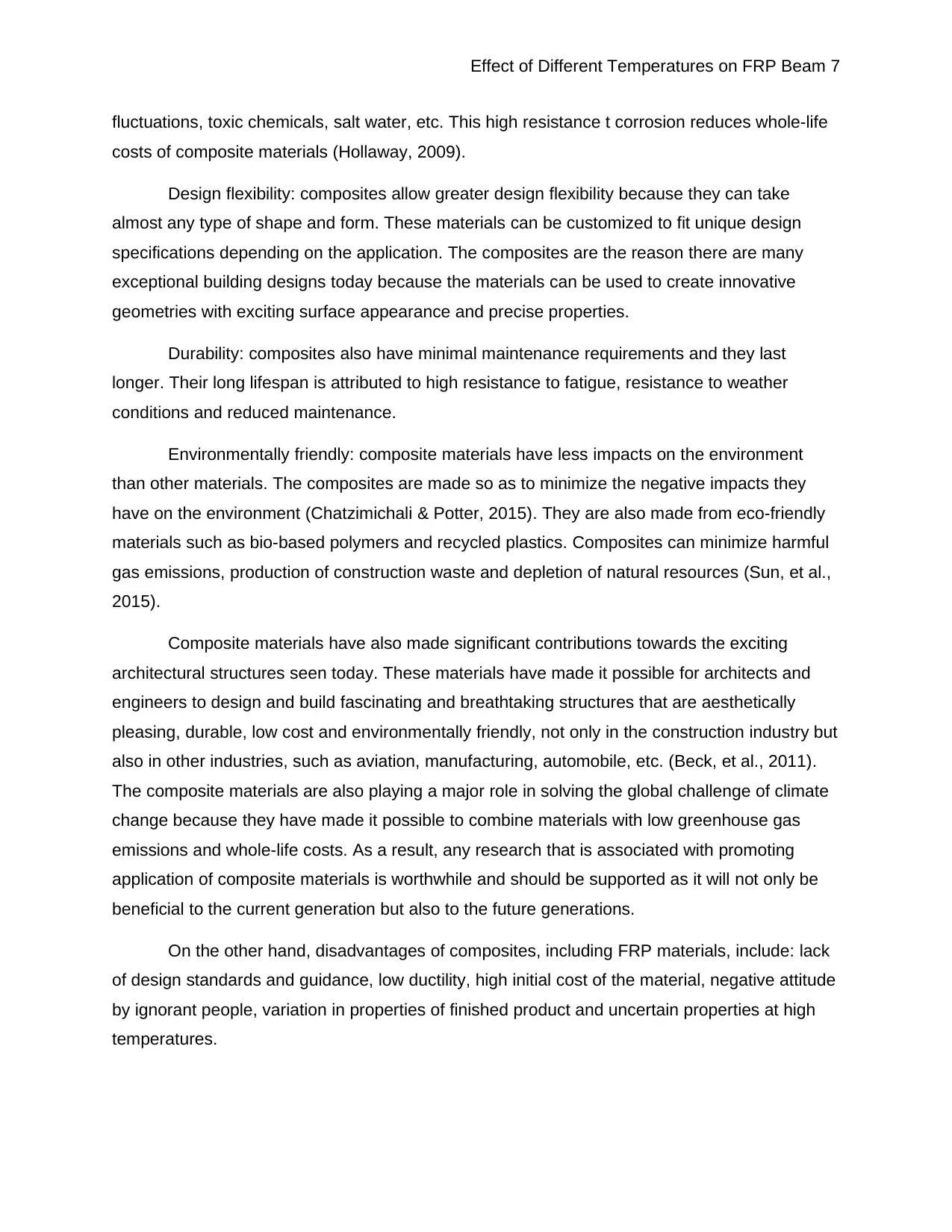
Effect of Different Temperatures on FRP Beam 7
fluctuations, toxic chemicals, salt water, etc. This high resistance t corrosion reduces whole-life
costs of composite materials (Hollaway, 2009).
Design flexibility: composites allow greater design flexibility because they can take
almost any type of shape and form. These materials can be customized to fit unique design
specifications depending on the application. The composites are the reason there are many
exceptional building designs today because the materials can be used to create innovative
geometries with exciting surface appearance and precise properties.
Durability: composites also have minimal maintenance requirements and they last
longer. Their long lifespan is attributed to high resistance to fatigue, resistance to weather
conditions and reduced maintenance.
Environmentally friendly: composite materials have less impacts on the environment
than other materials. The composites are made so as to minimize the negative impacts they
have on the environment (Chatzimichali & Potter, 2015). They are also made from eco-friendly
materials such as bio-based polymers and recycled plastics. Composites can minimize harmful
gas emissions, production of construction waste and depletion of natural resources (Sun, et al.,
2015).
Composite materials have also made significant contributions towards the exciting
architectural structures seen today. These materials have made it possible for architects and
engineers to design and build fascinating and breathtaking structures that are aesthetically
pleasing, durable, low cost and environmentally friendly, not only in the construction industry but
also in other industries, such as aviation, manufacturing, automobile, etc. (Beck, et al., 2011).
The composite materials are also playing a major role in solving the global challenge of climate
change because they have made it possible to combine materials with low greenhouse gas
emissions and whole-life costs. As a result, any research that is associated with promoting
application of composite materials is worthwhile and should be supported as it will not only be
beneficial to the current generation but also to the future generations.
On the other hand, disadvantages of composites, including FRP materials, include: lack
of design standards and guidance, low ductility, high initial cost of the material, negative attitude
by ignorant people, variation in properties of finished product and uncertain properties at high
temperatures.
fluctuations, toxic chemicals, salt water, etc. This high resistance t corrosion reduces whole-life
costs of composite materials (Hollaway, 2009).
Design flexibility: composites allow greater design flexibility because they can take
almost any type of shape and form. These materials can be customized to fit unique design
specifications depending on the application. The composites are the reason there are many
exceptional building designs today because the materials can be used to create innovative
geometries with exciting surface appearance and precise properties.
Durability: composites also have minimal maintenance requirements and they last
longer. Their long lifespan is attributed to high resistance to fatigue, resistance to weather
conditions and reduced maintenance.
Environmentally friendly: composite materials have less impacts on the environment
than other materials. The composites are made so as to minimize the negative impacts they
have on the environment (Chatzimichali & Potter, 2015). They are also made from eco-friendly
materials such as bio-based polymers and recycled plastics. Composites can minimize harmful
gas emissions, production of construction waste and depletion of natural resources (Sun, et al.,
2015).
Composite materials have also made significant contributions towards the exciting
architectural structures seen today. These materials have made it possible for architects and
engineers to design and build fascinating and breathtaking structures that are aesthetically
pleasing, durable, low cost and environmentally friendly, not only in the construction industry but
also in other industries, such as aviation, manufacturing, automobile, etc. (Beck, et al., 2011).
The composite materials are also playing a major role in solving the global challenge of climate
change because they have made it possible to combine materials with low greenhouse gas
emissions and whole-life costs. As a result, any research that is associated with promoting
application of composite materials is worthwhile and should be supported as it will not only be
beneficial to the current generation but also to the future generations.
On the other hand, disadvantages of composites, including FRP materials, include: lack
of design standards and guidance, low ductility, high initial cost of the material, negative attitude
by ignorant people, variation in properties of finished product and uncertain properties at high
temperatures.
Paraphrase This Document
Need a fresh take? Get an instant paraphrase of this document with our AI Paraphraser
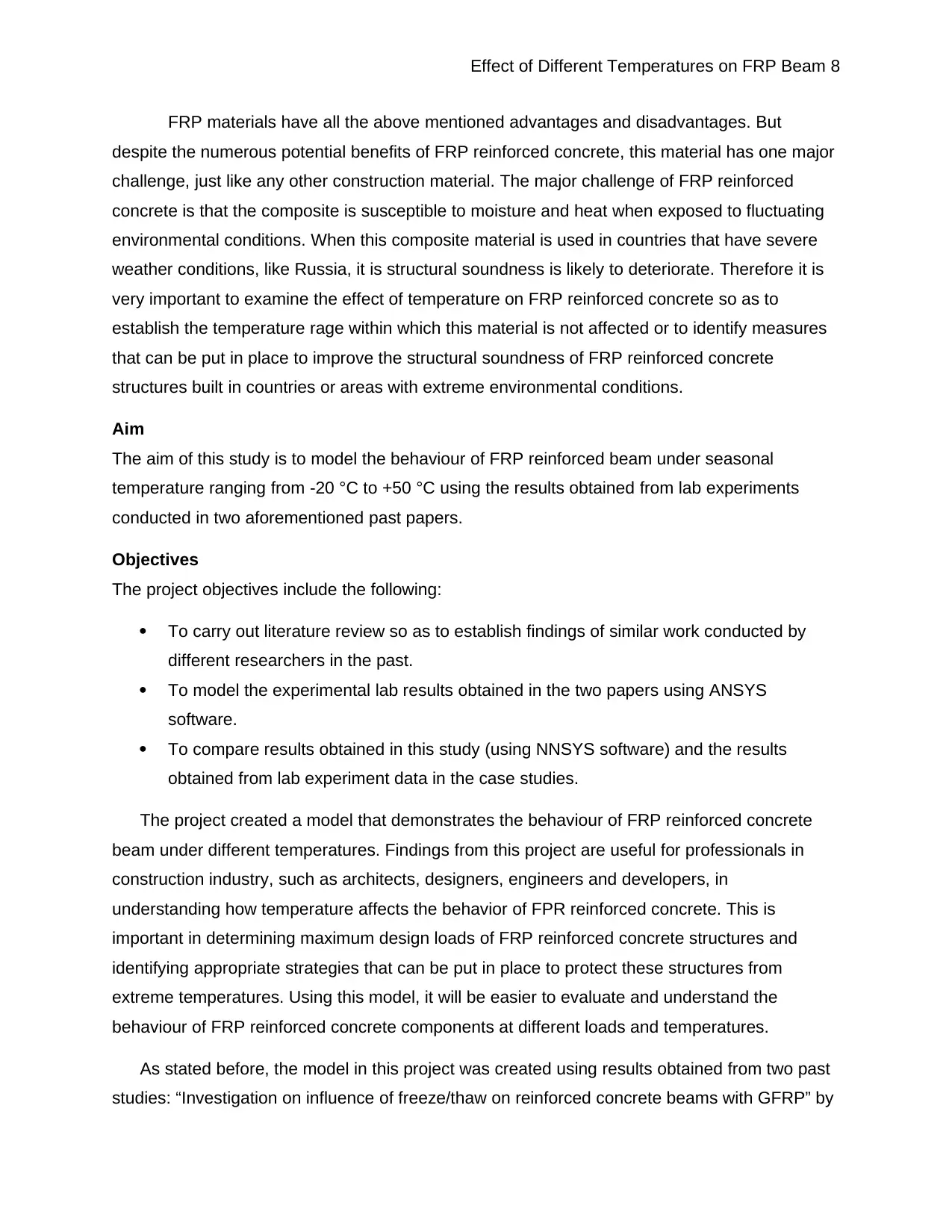
Effect of Different Temperatures on FRP Beam 8
FRP materials have all the above mentioned advantages and disadvantages. But
despite the numerous potential benefits of FRP reinforced concrete, this material has one major
challenge, just like any other construction material. The major challenge of FRP reinforced
concrete is that the composite is susceptible to moisture and heat when exposed to fluctuating
environmental conditions. When this composite material is used in countries that have severe
weather conditions, like Russia, it is structural soundness is likely to deteriorate. Therefore it is
very important to examine the effect of temperature on FRP reinforced concrete so as to
establish the temperature rage within which this material is not affected or to identify measures
that can be put in place to improve the structural soundness of FRP reinforced concrete
structures built in countries or areas with extreme environmental conditions.
Aim
The aim of this study is to model the behaviour of FRP reinforced beam under seasonal
temperature ranging from -20 °C to +50 °C using the results obtained from lab experiments
conducted in two aforementioned past papers.
Objectives
The project objectives include the following:
To carry out literature review so as to establish findings of similar work conducted by
different researchers in the past.
To model the experimental lab results obtained in the two papers using ANSYS
software.
To compare results obtained in this study (using NNSYS software) and the results
obtained from lab experiment data in the case studies.
The project created a model that demonstrates the behaviour of FRP reinforced concrete
beam under different temperatures. Findings from this project are useful for professionals in
construction industry, such as architects, designers, engineers and developers, in
understanding how temperature affects the behavior of FPR reinforced concrete. This is
important in determining maximum design loads of FRP reinforced concrete structures and
identifying appropriate strategies that can be put in place to protect these structures from
extreme temperatures. Using this model, it will be easier to evaluate and understand the
behaviour of FRP reinforced concrete components at different loads and temperatures.
As stated before, the model in this project was created using results obtained from two past
studies: “Investigation on influence of freeze/thaw on reinforced concrete beams with GFRP” by
FRP materials have all the above mentioned advantages and disadvantages. But
despite the numerous potential benefits of FRP reinforced concrete, this material has one major
challenge, just like any other construction material. The major challenge of FRP reinforced
concrete is that the composite is susceptible to moisture and heat when exposed to fluctuating
environmental conditions. When this composite material is used in countries that have severe
weather conditions, like Russia, it is structural soundness is likely to deteriorate. Therefore it is
very important to examine the effect of temperature on FRP reinforced concrete so as to
establish the temperature rage within which this material is not affected or to identify measures
that can be put in place to improve the structural soundness of FRP reinforced concrete
structures built in countries or areas with extreme environmental conditions.
Aim
The aim of this study is to model the behaviour of FRP reinforced beam under seasonal
temperature ranging from -20 °C to +50 °C using the results obtained from lab experiments
conducted in two aforementioned past papers.
Objectives
The project objectives include the following:
To carry out literature review so as to establish findings of similar work conducted by
different researchers in the past.
To model the experimental lab results obtained in the two papers using ANSYS
software.
To compare results obtained in this study (using NNSYS software) and the results
obtained from lab experiment data in the case studies.
The project created a model that demonstrates the behaviour of FRP reinforced concrete
beam under different temperatures. Findings from this project are useful for professionals in
construction industry, such as architects, designers, engineers and developers, in
understanding how temperature affects the behavior of FPR reinforced concrete. This is
important in determining maximum design loads of FRP reinforced concrete structures and
identifying appropriate strategies that can be put in place to protect these structures from
extreme temperatures. Using this model, it will be easier to evaluate and understand the
behaviour of FRP reinforced concrete components at different loads and temperatures.
As stated before, the model in this project was created using results obtained from two past
studies: “Investigation on influence of freeze/thaw on reinforced concrete beams with GFRP” by
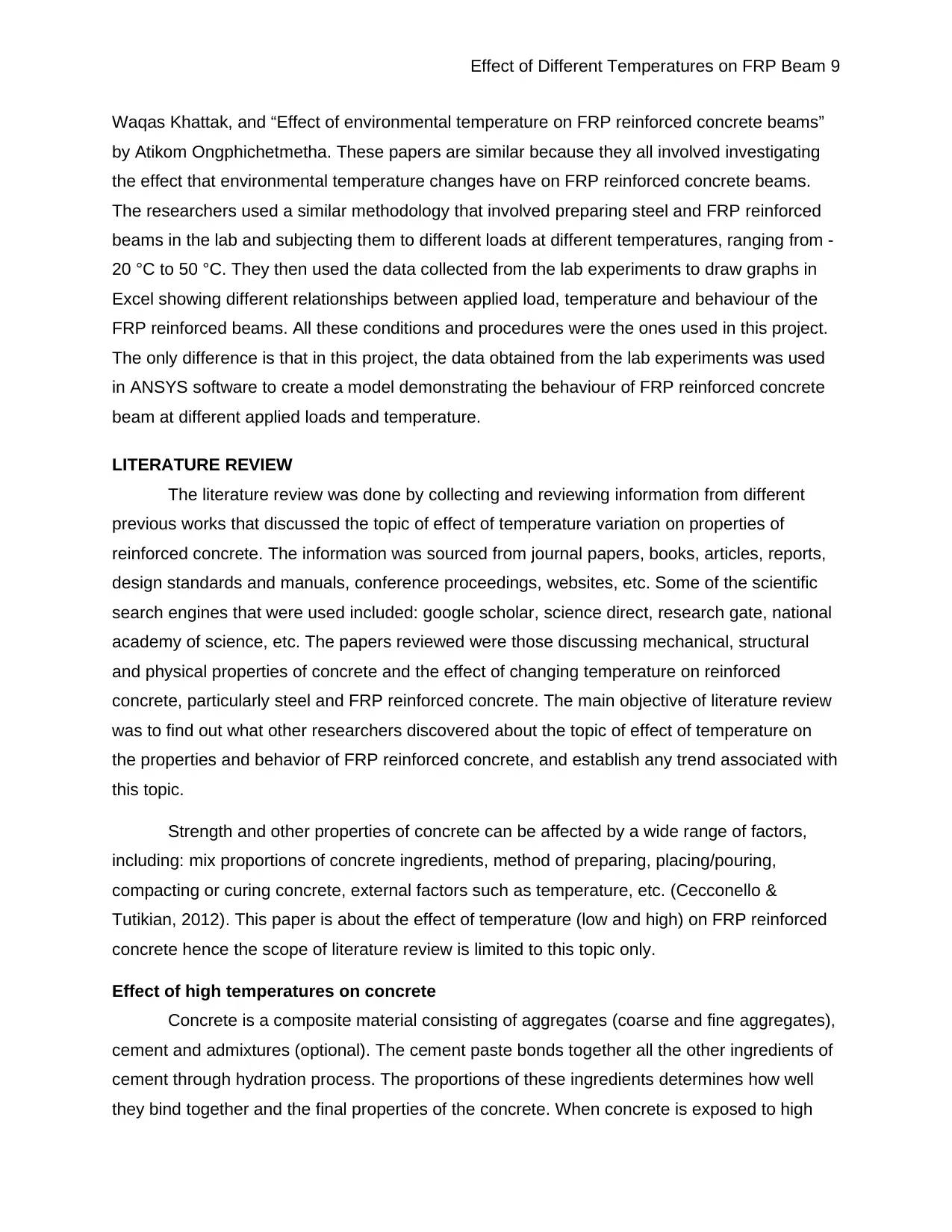
Effect of Different Temperatures on FRP Beam 9
Waqas Khattak, and “Effect of environmental temperature on FRP reinforced concrete beams”
by Atikom Ongphichetmetha. These papers are similar because they all involved investigating
the effect that environmental temperature changes have on FRP reinforced concrete beams.
The researchers used a similar methodology that involved preparing steel and FRP reinforced
beams in the lab and subjecting them to different loads at different temperatures, ranging from -
20 °C to 50 °C. They then used the data collected from the lab experiments to draw graphs in
Excel showing different relationships between applied load, temperature and behaviour of the
FRP reinforced beams. All these conditions and procedures were the ones used in this project.
The only difference is that in this project, the data obtained from the lab experiments was used
in ANSYS software to create a model demonstrating the behaviour of FRP reinforced concrete
beam at different applied loads and temperature.
LITERATURE REVIEW
The literature review was done by collecting and reviewing information from different
previous works that discussed the topic of effect of temperature variation on properties of
reinforced concrete. The information was sourced from journal papers, books, articles, reports,
design standards and manuals, conference proceedings, websites, etc. Some of the scientific
search engines that were used included: google scholar, science direct, research gate, national
academy of science, etc. The papers reviewed were those discussing mechanical, structural
and physical properties of concrete and the effect of changing temperature on reinforced
concrete, particularly steel and FRP reinforced concrete. The main objective of literature review
was to find out what other researchers discovered about the topic of effect of temperature on
the properties and behavior of FRP reinforced concrete, and establish any trend associated with
this topic.
Strength and other properties of concrete can be affected by a wide range of factors,
including: mix proportions of concrete ingredients, method of preparing, placing/pouring,
compacting or curing concrete, external factors such as temperature, etc. (Cecconello &
Tutikian, 2012). This paper is about the effect of temperature (low and high) on FRP reinforced
concrete hence the scope of literature review is limited to this topic only.
Effect of high temperatures on concrete
Concrete is a composite material consisting of aggregates (coarse and fine aggregates),
cement and admixtures (optional). The cement paste bonds together all the other ingredients of
cement through hydration process. The proportions of these ingredients determines how well
they bind together and the final properties of the concrete. When concrete is exposed to high
Waqas Khattak, and “Effect of environmental temperature on FRP reinforced concrete beams”
by Atikom Ongphichetmetha. These papers are similar because they all involved investigating
the effect that environmental temperature changes have on FRP reinforced concrete beams.
The researchers used a similar methodology that involved preparing steel and FRP reinforced
beams in the lab and subjecting them to different loads at different temperatures, ranging from -
20 °C to 50 °C. They then used the data collected from the lab experiments to draw graphs in
Excel showing different relationships between applied load, temperature and behaviour of the
FRP reinforced beams. All these conditions and procedures were the ones used in this project.
The only difference is that in this project, the data obtained from the lab experiments was used
in ANSYS software to create a model demonstrating the behaviour of FRP reinforced concrete
beam at different applied loads and temperature.
LITERATURE REVIEW
The literature review was done by collecting and reviewing information from different
previous works that discussed the topic of effect of temperature variation on properties of
reinforced concrete. The information was sourced from journal papers, books, articles, reports,
design standards and manuals, conference proceedings, websites, etc. Some of the scientific
search engines that were used included: google scholar, science direct, research gate, national
academy of science, etc. The papers reviewed were those discussing mechanical, structural
and physical properties of concrete and the effect of changing temperature on reinforced
concrete, particularly steel and FRP reinforced concrete. The main objective of literature review
was to find out what other researchers discovered about the topic of effect of temperature on
the properties and behavior of FRP reinforced concrete, and establish any trend associated with
this topic.
Strength and other properties of concrete can be affected by a wide range of factors,
including: mix proportions of concrete ingredients, method of preparing, placing/pouring,
compacting or curing concrete, external factors such as temperature, etc. (Cecconello &
Tutikian, 2012). This paper is about the effect of temperature (low and high) on FRP reinforced
concrete hence the scope of literature review is limited to this topic only.
Effect of high temperatures on concrete
Concrete is a composite material consisting of aggregates (coarse and fine aggregates),
cement and admixtures (optional). The cement paste bonds together all the other ingredients of
cement through hydration process. The proportions of these ingredients determines how well
they bind together and the final properties of the concrete. When concrete is exposed to high
⊘ This is a preview!⊘
Do you want full access?
Subscribe today to unlock all pages.

Trusted by 1+ million students worldwide

Effect of Different Temperatures on FRP Beam 10
temperatures, it undergoes numerous changes that alter its mechanical and physical properties.
This change is as a result of a change in moisture content, which affects the bond between
aggregates and cement paste. Therefore the bond between cement paste and aggregates gets
significantly affected if the concrete is exposed to high temperature variations i.e. large thermal
expansion variance (Klein & Nellis, 2012). By definition, thermal expansion refers to the ability of
a material to change its physical properties and shape when it is exposed to different
temperatures. Temperature change affects the surface condition of aggregates and the
interaction between physical and chemical interface, which in turn affects the bonding quality of
the concrete. Therefore high temperature weakens the interfacial bond between cement paste
and aggregates (Salau, et al., 2015).
The behaviour of concrete at high temperatures is affected by several conditions,
including: moisture content, the highest temperature attained, rate of temperature increase, type
of aggregate, loading and time (Ma, et al., 2015). When concrete is being cured, the duration of
curing depends on several factors such as desired strength of concrete, mix proportions, and
exposure conditions. When temperature changes abruptly, thermal shock can cause cracking
and spalling of concrete, while aggregate expansion can cause concrete distress. All these
factors also affect the hydration process of concrete. The condition of cement paste is affected
by the temperature in which the concrete is exposed to and thus affect the final strength of
concrete. When this temperature increases to the extreme over a long period of time, the
strength of concrete will also be adversely affected. Generally, the strength of concrete
decreases with rising temperature.
In a study conducted by Alex (2015) to determine the suitability of different types of FRP
reinforcements accepted for use in Germany, it was found that FRP reinforcements performs
well within a certain range of temperature, that is, temperature variance is a major factor
affecting performance and behavior of FRP reinforcement. One of the findings of the study was
that one of the disadvantages of FRP reinforced concrete is that it is suitable for use in
conditions with a maximum temperature of 40 °C (Alex, 2015). The research concluded that it is
important to define the characteristics and scope of FRP reinforcement so that it is not used in
conditions where its physical, mechanical and structural properties will deteriorate considerably.
This is important as it will help the user determine whether the FRP reinforcement is suitable for
use in the intended environmental conditions or not. This information can also be useful when
developing design standards and guidelines of RFP reinforced concrete (Teng, et al., 2008).
temperatures, it undergoes numerous changes that alter its mechanical and physical properties.
This change is as a result of a change in moisture content, which affects the bond between
aggregates and cement paste. Therefore the bond between cement paste and aggregates gets
significantly affected if the concrete is exposed to high temperature variations i.e. large thermal
expansion variance (Klein & Nellis, 2012). By definition, thermal expansion refers to the ability of
a material to change its physical properties and shape when it is exposed to different
temperatures. Temperature change affects the surface condition of aggregates and the
interaction between physical and chemical interface, which in turn affects the bonding quality of
the concrete. Therefore high temperature weakens the interfacial bond between cement paste
and aggregates (Salau, et al., 2015).
The behaviour of concrete at high temperatures is affected by several conditions,
including: moisture content, the highest temperature attained, rate of temperature increase, type
of aggregate, loading and time (Ma, et al., 2015). When concrete is being cured, the duration of
curing depends on several factors such as desired strength of concrete, mix proportions, and
exposure conditions. When temperature changes abruptly, thermal shock can cause cracking
and spalling of concrete, while aggregate expansion can cause concrete distress. All these
factors also affect the hydration process of concrete. The condition of cement paste is affected
by the temperature in which the concrete is exposed to and thus affect the final strength of
concrete. When this temperature increases to the extreme over a long period of time, the
strength of concrete will also be adversely affected. Generally, the strength of concrete
decreases with rising temperature.
In a study conducted by Alex (2015) to determine the suitability of different types of FRP
reinforcements accepted for use in Germany, it was found that FRP reinforcements performs
well within a certain range of temperature, that is, temperature variance is a major factor
affecting performance and behavior of FRP reinforcement. One of the findings of the study was
that one of the disadvantages of FRP reinforced concrete is that it is suitable for use in
conditions with a maximum temperature of 40 °C (Alex, 2015). The research concluded that it is
important to define the characteristics and scope of FRP reinforcement so that it is not used in
conditions where its physical, mechanical and structural properties will deteriorate considerably.
This is important as it will help the user determine whether the FRP reinforcement is suitable for
use in the intended environmental conditions or not. This information can also be useful when
developing design standards and guidelines of RFP reinforced concrete (Teng, et al., 2008).
Paraphrase This Document
Need a fresh take? Get an instant paraphrase of this document with our AI Paraphraser
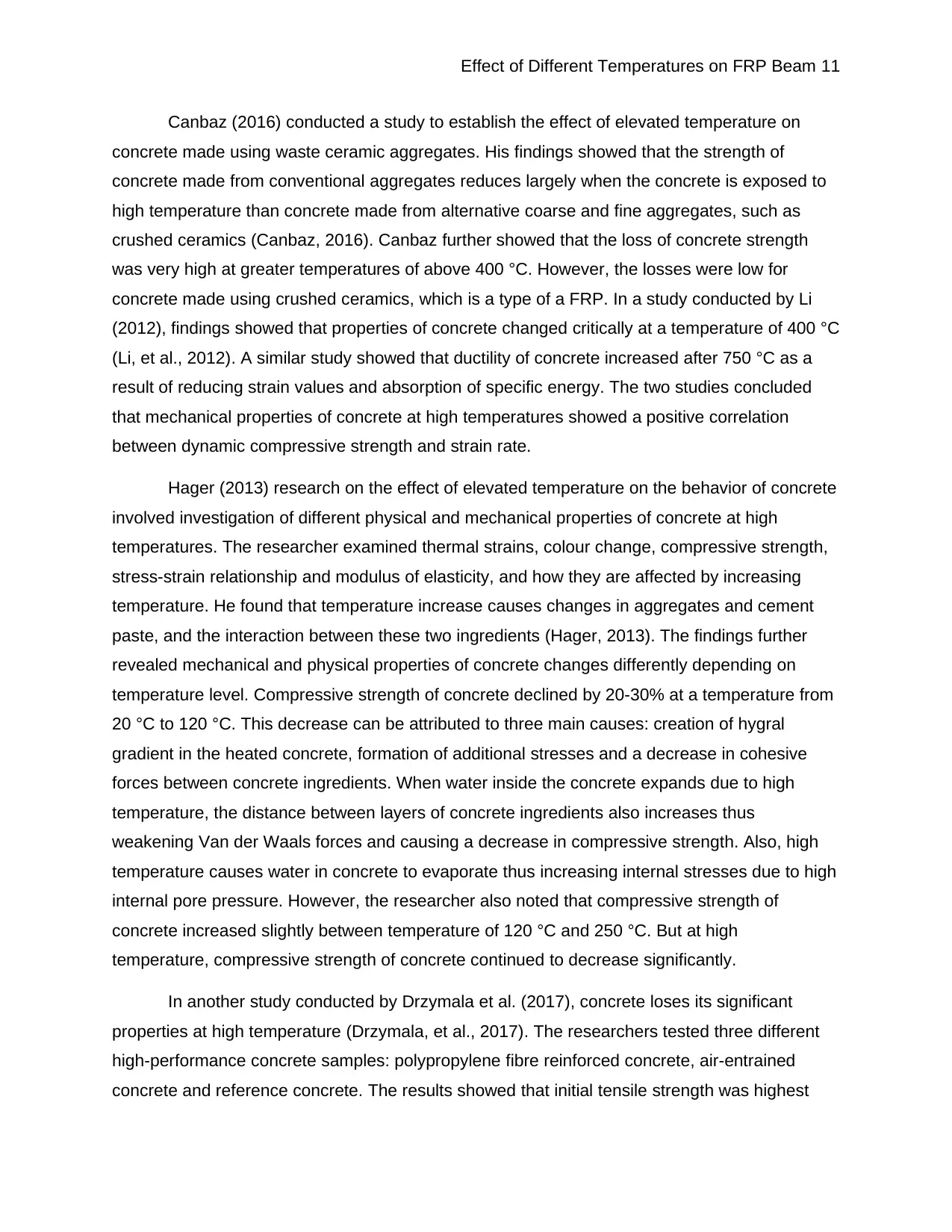
Effect of Different Temperatures on FRP Beam 11
Canbaz (2016) conducted a study to establish the effect of elevated temperature on
concrete made using waste ceramic aggregates. His findings showed that the strength of
concrete made from conventional aggregates reduces largely when the concrete is exposed to
high temperature than concrete made from alternative coarse and fine aggregates, such as
crushed ceramics (Canbaz, 2016). Canbaz further showed that the loss of concrete strength
was very high at greater temperatures of above 400 °C. However, the losses were low for
concrete made using crushed ceramics, which is a type of a FRP. In a study conducted by Li
(2012), findings showed that properties of concrete changed critically at a temperature of 400 °C
(Li, et al., 2012). A similar study showed that ductility of concrete increased after 750 °C as a
result of reducing strain values and absorption of specific energy. The two studies concluded
that mechanical properties of concrete at high temperatures showed a positive correlation
between dynamic compressive strength and strain rate.
Hager (2013) research on the effect of elevated temperature on the behavior of concrete
involved investigation of different physical and mechanical properties of concrete at high
temperatures. The researcher examined thermal strains, colour change, compressive strength,
stress-strain relationship and modulus of elasticity, and how they are affected by increasing
temperature. He found that temperature increase causes changes in aggregates and cement
paste, and the interaction between these two ingredients (Hager, 2013). The findings further
revealed mechanical and physical properties of concrete changes differently depending on
temperature level. Compressive strength of concrete declined by 20-30% at a temperature from
20 °C to 120 °C. This decrease can be attributed to three main causes: creation of hygral
gradient in the heated concrete, formation of additional stresses and a decrease in cohesive
forces between concrete ingredients. When water inside the concrete expands due to high
temperature, the distance between layers of concrete ingredients also increases thus
weakening Van der Waals forces and causing a decrease in compressive strength. Also, high
temperature causes water in concrete to evaporate thus increasing internal stresses due to high
internal pore pressure. However, the researcher also noted that compressive strength of
concrete increased slightly between temperature of 120 °C and 250 °C. But at high
temperature, compressive strength of concrete continued to decrease significantly.
In another study conducted by Drzymala et al. (2017), concrete loses its significant
properties at high temperature (Drzymala, et al., 2017). The researchers tested three different
high-performance concrete samples: polypropylene fibre reinforced concrete, air-entrained
concrete and reference concrete. The results showed that initial tensile strength was highest
Canbaz (2016) conducted a study to establish the effect of elevated temperature on
concrete made using waste ceramic aggregates. His findings showed that the strength of
concrete made from conventional aggregates reduces largely when the concrete is exposed to
high temperature than concrete made from alternative coarse and fine aggregates, such as
crushed ceramics (Canbaz, 2016). Canbaz further showed that the loss of concrete strength
was very high at greater temperatures of above 400 °C. However, the losses were low for
concrete made using crushed ceramics, which is a type of a FRP. In a study conducted by Li
(2012), findings showed that properties of concrete changed critically at a temperature of 400 °C
(Li, et al., 2012). A similar study showed that ductility of concrete increased after 750 °C as a
result of reducing strain values and absorption of specific energy. The two studies concluded
that mechanical properties of concrete at high temperatures showed a positive correlation
between dynamic compressive strength and strain rate.
Hager (2013) research on the effect of elevated temperature on the behavior of concrete
involved investigation of different physical and mechanical properties of concrete at high
temperatures. The researcher examined thermal strains, colour change, compressive strength,
stress-strain relationship and modulus of elasticity, and how they are affected by increasing
temperature. He found that temperature increase causes changes in aggregates and cement
paste, and the interaction between these two ingredients (Hager, 2013). The findings further
revealed mechanical and physical properties of concrete changes differently depending on
temperature level. Compressive strength of concrete declined by 20-30% at a temperature from
20 °C to 120 °C. This decrease can be attributed to three main causes: creation of hygral
gradient in the heated concrete, formation of additional stresses and a decrease in cohesive
forces between concrete ingredients. When water inside the concrete expands due to high
temperature, the distance between layers of concrete ingredients also increases thus
weakening Van der Waals forces and causing a decrease in compressive strength. Also, high
temperature causes water in concrete to evaporate thus increasing internal stresses due to high
internal pore pressure. However, the researcher also noted that compressive strength of
concrete increased slightly between temperature of 120 °C and 250 °C. But at high
temperature, compressive strength of concrete continued to decrease significantly.
In another study conducted by Drzymala et al. (2017), concrete loses its significant
properties at high temperature (Drzymala, et al., 2017). The researchers tested three different
high-performance concrete samples: polypropylene fibre reinforced concrete, air-entrained
concrete and reference concrete. The results showed that initial tensile strength was highest
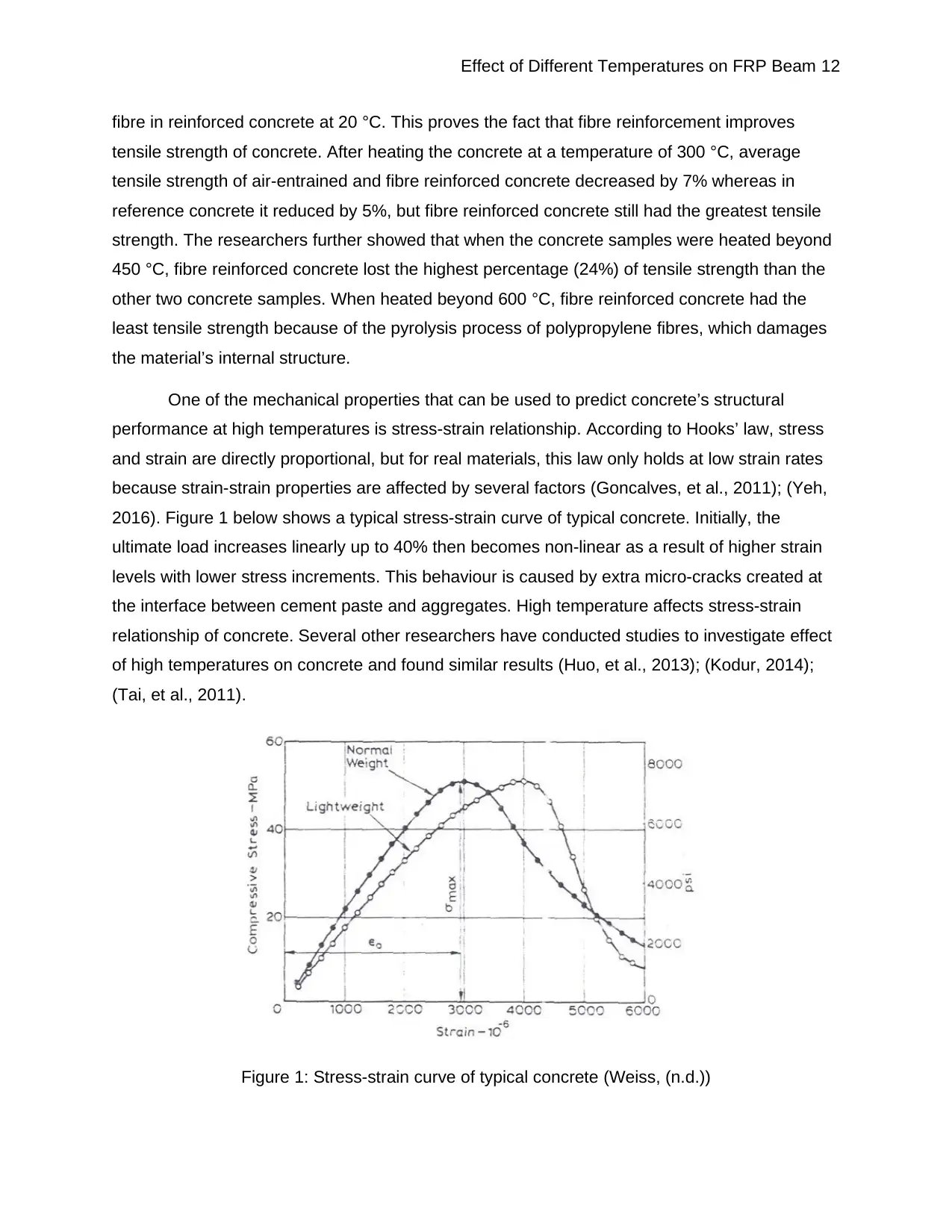
Effect of Different Temperatures on FRP Beam 12
fibre in reinforced concrete at 20 °C. This proves the fact that fibre reinforcement improves
tensile strength of concrete. After heating the concrete at a temperature of 300 °C, average
tensile strength of air-entrained and fibre reinforced concrete decreased by 7% whereas in
reference concrete it reduced by 5%, but fibre reinforced concrete still had the greatest tensile
strength. The researchers further showed that when the concrete samples were heated beyond
450 °C, fibre reinforced concrete lost the highest percentage (24%) of tensile strength than the
other two concrete samples. When heated beyond 600 °C, fibre reinforced concrete had the
least tensile strength because of the pyrolysis process of polypropylene fibres, which damages
the material’s internal structure.
One of the mechanical properties that can be used to predict concrete’s structural
performance at high temperatures is stress-strain relationship. According to Hooks’ law, stress
and strain are directly proportional, but for real materials, this law only holds at low strain rates
because strain-strain properties are affected by several factors (Goncalves, et al., 2011); (Yeh,
2016). Figure 1 below shows a typical stress-strain curve of typical concrete. Initially, the
ultimate load increases linearly up to 40% then becomes non-linear as a result of higher strain
levels with lower stress increments. This behaviour is caused by extra micro-cracks created at
the interface between cement paste and aggregates. High temperature affects stress-strain
relationship of concrete. Several other researchers have conducted studies to investigate effect
of high temperatures on concrete and found similar results (Huo, et al., 2013); (Kodur, 2014);
(Tai, et al., 2011).
Figure 1: Stress-strain curve of typical concrete (Weiss, (n.d.))
fibre in reinforced concrete at 20 °C. This proves the fact that fibre reinforcement improves
tensile strength of concrete. After heating the concrete at a temperature of 300 °C, average
tensile strength of air-entrained and fibre reinforced concrete decreased by 7% whereas in
reference concrete it reduced by 5%, but fibre reinforced concrete still had the greatest tensile
strength. The researchers further showed that when the concrete samples were heated beyond
450 °C, fibre reinforced concrete lost the highest percentage (24%) of tensile strength than the
other two concrete samples. When heated beyond 600 °C, fibre reinforced concrete had the
least tensile strength because of the pyrolysis process of polypropylene fibres, which damages
the material’s internal structure.
One of the mechanical properties that can be used to predict concrete’s structural
performance at high temperatures is stress-strain relationship. According to Hooks’ law, stress
and strain are directly proportional, but for real materials, this law only holds at low strain rates
because strain-strain properties are affected by several factors (Goncalves, et al., 2011); (Yeh,
2016). Figure 1 below shows a typical stress-strain curve of typical concrete. Initially, the
ultimate load increases linearly up to 40% then becomes non-linear as a result of higher strain
levels with lower stress increments. This behaviour is caused by extra micro-cracks created at
the interface between cement paste and aggregates. High temperature affects stress-strain
relationship of concrete. Several other researchers have conducted studies to investigate effect
of high temperatures on concrete and found similar results (Huo, et al., 2013); (Kodur, 2014);
(Tai, et al., 2011).
Figure 1: Stress-strain curve of typical concrete (Weiss, (n.d.))
⊘ This is a preview!⊘
Do you want full access?
Subscribe today to unlock all pages.

Trusted by 1+ million students worldwide
1 out of 50
Related Documents
Your All-in-One AI-Powered Toolkit for Academic Success.
+13062052269
info@desklib.com
Available 24*7 on WhatsApp / Email
![[object Object]](/_next/static/media/star-bottom.7253800d.svg)
Unlock your academic potential
Copyright © 2020–2025 A2Z Services. All Rights Reserved. Developed and managed by ZUCOL.


